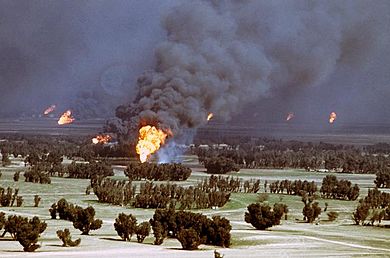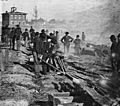Scorched earth facts for kids
A scorched-earth policy is a military plan. It means destroying everything that could help an enemy army. This is done when an army is moving through an area or leaving it. Things like food, water, roads, communication systems, factories, and even homes can be targeted. The goal is to make it impossible for the enemy to live off the land or use its resources.
This policy can be used by an army in enemy lands. It can also be used by an army in its own country.
Contents
What is a Scorched-Earth Policy?
A scorched-earth policy is a military tactic. It involves destroying resources that an enemy might use. This includes food, water, transport, and buildings. The aim is to weaken the enemy. It makes it harder for them to survive or fight.
This strategy can be used by an army. It might be in an enemy's territory. Or, it could be in an army's own land. This happens when they are retreating. They want to leave nothing useful behind.
Famous Examples in History
Many times in history, armies have used this tactic. Here are some well-known examples:
Early Uses of Scorched Earth
- Swedish Invasion of Russia: In the early 1700s, the Russian army used this plan. They destroyed their own land. This made it hard for the Swedish army to find food.
- Napoleon's Invasion of Russia: In 1812, Napoleon led his French army into Russia. The Russian army retreated. They burned crops and villages. This left Napoleon's soldiers with no supplies. Many died from hunger and cold.
American Civil War Tactics
- Sherman's March to the Sea: During the American Civil War, General William Tecumseh Sherman led Union troops. In 1864, they marched through Georgia. They destroyed farms, railways, and factories. This was to break the South's ability to fight.
- Navajo "Long Walk": In the 1860s, Colonel Kit Carson led US forces. They destroyed Navajo homes and food sources. This forced the Navajo people to leave their lands. They were made to walk hundreds of miles.
World Wars and Beyond
- World War I - German Retreat: In 1917, German forces retreated on the Western Front. They destroyed bridges and towns. This slowed down the Allied armies.
- World War II - Eastern Front:
* Soviet Union's Defense: When Nazi Germany invaded in 1941, the Soviet army retreated. Under Joseph Stalin's orders, they burned farms and factories. This was to stop the Germans from using them. * Nazi German Retreat: Later in the war, the German army also used this. As they retreated from the Soviet Union, they destroyed everything. They wanted to make it hard for the Soviets to follow.
- Gulf War - Kuwaiti Oil Fires: In 1991, Iraqi forces retreated from Kuwait. They set fire to over 600 oil wells. This caused huge environmental damage. It also made it harder for Kuwait to recover.
Images for kids
-
Corfe Castle was slighted during the English Civil War so that its defences could not be reused.
-
The forces of Vlad the Impaler were associated with torches, particularly outside Târgovişte.
-
William Tecumseh Sherman's troops destroying a railroad near Atlanta
-
The ruins of Richmond, Virginia after it was burned by retreating Confederate soldiers in April 1865.
-
Boer civilians watching British soldiers blow up their house with dynamite after they had been given 10 minutes to gather their belongings.
-
Ruins of the church of St. Jean in Péronne, blown up by the Germans in March 1917
-
Turkish medics arrived at a town to rescue wounded on the way to Izmir after Greek forces abandoned the town (August 1922).
-
Nazi Germany's scorched-earth policy in the Soviet Union in 1943. In this photograph, taken by a Wehrmacht propaganda company, the original 1943 caption reads, "Russia. Burning houses / huts in village".
See also
 In Spanish: Tierra quemada para niños
In Spanish: Tierra quemada para niños















